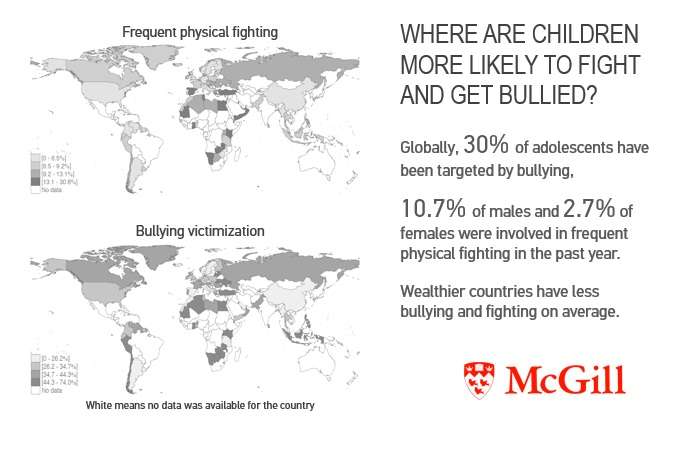Youth violence undermines social and economic development in poorest corners of the world

Youth violence undermines social and economic development, especially in the poorest corners of the world, according to research from McGill University. However, increased government spending on education may be the key to facilitate policy efforts to protect youth.
Using data from two international school-based surveys, the Health Behaviour in School-aged Children and Global School-based Health Survey, Frank Elgar, a professor at the Institute for Health and Social Policy (IHSP) at McGill University reports on rates of bullying and physical fighting in 79 countries in The Journal of Adolescent Health. The study focused on bullying victimisation (repeated physical or verbal aggression, involving a power imbalance between victim and aggressor) during the previous two months and frequent physical fighting (4+ episodes) in the previous year) in over 330,000 youths 11- to 16-years-old.
Elgar and colleagues linked these records to information about the countries' per capita income, income inequality, and government spending on education.
"Bullying and physical fighting are far more prevalent in poorer countries", says Elgar, "However, we found that in wealthy but unequal countries, physical fighting may be reduced through greater government investment in education."
Higher rates of bullying in Canada
"We were surprised by the rate of bullying in Canada—about 7 percentage points higher than the international average. About 37% of Canadian youth have been the target of bullying in the past two months. This is higher than the United States and most European countries."
Highlights:
- Largest study to date on youth violence on an international level
- Study found large country differences in youth violence: a six-fold difference in school bullying and 12-fold difference in fighting between rich and poor countries
- Globally, about 30% of youth has been the target of school bullying during the previous month. In Africa, the figure is about 50%.
- 10.7% of males and 2.7% of females were involved in four or more episodes of physical fighting in the past year.
- Canada has higher levels of school bullying than many countries of similar wealth: 37.6% of males and 37.2% of females have been the target of bullying.
- Fighting in Canadian youth is near international norms: 10.3% of males and 3.8% of females were involved in 4 or more episodes of fighting in the past year.
- In the US, fighting is twice as common in males (8.4%) than in females (3.9%). Bullying is near the international norm: 30.8% of males and 29.7% females in the US have been the target of bullying.
- European countries have the lowest rates of youth violence - in terms of fighting (4.1% males, 1.1% females) and bullying 12.4% males, 8.7% females).
- Physical fighting in affluent but economically unequal countries might be reduced through increased government spending on education.
More information: "Structural determinants of youth bullying and fighting in 79 countries" by Frank Elgar et al. is published in the Journal of Adolescent Health: www.sciencedirect.com/science/ … ii/S1054139X15003298


















